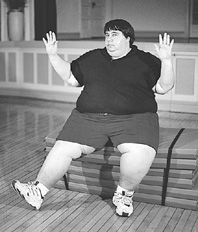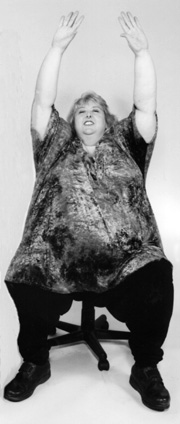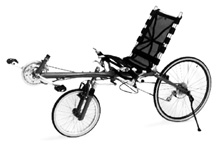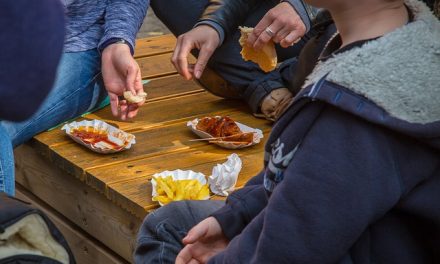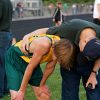- Why should I be active?
- How do I get started?
- What physical activities can a very large person do?
- Safety Tips
- Additional Resources
Do you feel that you can barely do any activity at all? That you can�t exercise, play sports, or become more fit? If you are a very large person, you can still be physically active.
Very large people face special challenges in trying to be active. You may not be able to bend or move in the same way that other people can. It may be hard to find clothes and equipment for exercising. You may feel self-conscious being active around other people.
Facing these challenges is hard�but it can be done! This article can help you start being more active and healthier�no matter what your size!
Why should I be active?
Being active helps you live longerand protects you from:
- diabetes
- heart disease and stroke
- high blood pressure
- osteoporosis (a disease leading to weak bones that can break easily)
- osteoarthritis (wearing away of the tissue that protects the joints).

Regular physical activity helps you feel better because it:
- improves your self-image
- lowers your stress
- boosts your mood
- gives you more energy
- helps you move with more grace and confidence
- helps you fall asleep at night and sleep well
- increases your strength.
Being active can be big fun!
How do I get started?
|
To start being more active and keep at it:
- Start slowly. Your body needs time to get used to your new activity.
- Warm up. Warm-ups get your body ready for action. Shrug your shoulders, tap your toes, swing your arms, or march in place. You should spend a few minutes warming up for any activity�even walking.
- Cool down. Slow down little by little. If you have been walking fast, walk slower to cool down. Or stretch for a few minutes. Cooling down may protect your heart, relax your muscles, and keep you from getting hurt.
- Set goals. Set short-term and long-term goals. A short-term goal may be to walk 5 minutes at least 3 days for 1 week. A long-term goal may be to walk 30 minutes most days of the week by the end of 6 months.
- Track progress. Keep a journal of your activity. You may not feel like you are making progress but when you look back at where you started, you may be pleasantly surprised!
- Fit activity into your daily life. Plan ahead and try to be active when it works best for you.
- Get support. Get a family member or friend to be active with you. It may be more fun, and an exercise buddy can cheer you on.
- Have fun! Try different activities to find the ones you really enjoy.
What physical activities can
a very large person do?
Do I need to see my health care provider before I start exercising? You should see your doctor if:
- you have not been active for years
- you are active now and are changing from a moderate to a more intense activity
- you have diabetes, heart disease, or high blood pressure
- you have arthritis or an injury (like a knee injury).
You can do:
- sports
- planned exercise
- household chores
- yard work
- social activities (like dancing).
Exercise or physical activity does not have to be hard or boring to be good for you. Anything that gets you moving around�even for only a few minutes a day�is a healthy start to getting more fit.
Most very large people can do some or all of the activities in this article. You don�t need special skills or a lot of equipment.
This article describes both weightbearingand non-weightbearing activities. Weightbearing activities, like walking, bowling, and golfing involve lifting or pushing your own body weight.
Non-weightbearing activities, like swimming, put less stress on your joints because you don�t have to lift or push your own weight. If your feet or joints hurt when you stand, non-weightbearing activities may be best for you.
|
Walking (weightbearing)
The walking that you do during the day (like doing chores around the house or in the yard) can help you be more fit. But regular, steady walking that makes you breathe heavier can help you to be healthier. It will give your heart and lungs�as well as your leg muscles�a good workout.
If you are not active now, start slowly. Try to walk 5 minutes a day for the first week. Walk 8 minutes the next week. Stay at 8�minute walks until you feel comfortable. Then increase your walks to 11 minutes. Slowly lengthen each walk by 3 minutes�or walk faster.
Tips for walking:
- Stand up straight, lift your rib cage, and look straight ahead (but keep your shoulders relaxed). This will let your spine curve in a natural, healthy position.
- Swing your arms and move at a steady pace. This will also help keep your fingers from swelling.
- Wear comfortable walking shoes with a lot of support. If you walk often, you may need to buy new shoes every 6 to 8 months.
- Make walking fun. Walk with a friend or pet. Walk in places you enjoy, like a park or shopping mall.
To learn more, read Walking...A Step in the Right Direction.
Dancing (weightbearing or non-weightbearing)
Dancing helps:
- tone your muscles
- improve your flexiblity
- make your heart stronger
- make your lungs work better.
You can dance in a health club, in a nightclub, or at home. To dance at home, just move your body to some lively music!
Dancing on your feet is a weightbearing activity. Dancing while seated lets you move your arms and legs to music while taking the weight off your feet. This may be a good choice if you can�t stand on your feet very long.
See the list of resources at the end of this article for seated workout videos.
|
Water Workouts (non-weightbearing)
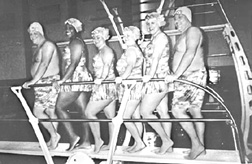
Exercising in water helps you feel:
Flexible. You can bend and move your body in water in ways you can�t on land.
Strong. Working against the water will help your body get stronger.
At less risk of injury. Water makes your body float. This keeps your joints from being pounded or jarred and helps prevent sore muscles and injury.
Refreshed. You can keep cooler in water�even when you are working hard.
You don�t need to know how to swim to work out in water�you can do shallow-water or deep-water exercises without swimming.
For shallow-water exercise, the water level should be between your waist and your chest. If the water is too shallow, it will be hard to move your arms underwater. If the water is deeper than chest height, it will be hard to keep your feet touching the pool bottom.
For deep-water exercise, most of your body is underwater. This means that your whole body will get a good workout. For safety and comfort, wear a foam belt or life jacket.
Many swim centers offer classes in water workouts. Check with the ones in your area to find the best water workout for you.
See the list of resources at the end of this article to learn more about water exercises.
Weight Training (weightbearing or non-weightbearing)
|
Weight training builds strong muscles and bones. You can weight train at home or at a fitness center.
You don�t need benches or bars to begin weight training at home. You can use a pair of hand weights or even two soup cans.
Make sure you know the correct posture and that your movements are slow and controlled.
Before you buy a home gym, check its weight rating (the number of pounds it can support) to make sure it is safe for your size. If you want to join a fitness center where you can use weights, shop around for one where you feel at ease.
To learn more about weight training, see the list of resources at the end of this article.
Bicycling(non-weightbearing)
| You can bicycle indoors on an exercise bike, or outdoors on a road bike. Biking does not stress any one part of the body�your weight is spread between your arms, back, and hips. You may want to use a recumbent bike. On this type of bike, you sit low to the ground with your legs reaching forward to the pedals. This may feel better than sitting upright. The seat on a recumbent bike is also wider than the seat on an upright bike. | |
For biking outdoors, you may want to try a mountain bike. These bikes have wider tires and are heavy. You can also buy a larger seat to put on your bike.
Make sure the bike you buy has a weight rating at least as high as your own weight.
To learn more about bicycling, see the list of resources at the end of this article.
Stretching (weightbearing or non-weightbearing)
|
Stretching helps:
- make you more flexible (to help keep you from getting hurt)
- make you feel relaxed
- improve your blood flow
- keep your muscles from getting tight after doing other exercises.
You don�t have to set aside a special time or place to stretch. At home or at work, stand up, push your arms toward the ceiling, and stretch. Stretch slowly and only enough to feel tightness�not until you feel pain. Hold the stretch, without bouncing, for about 30 seconds. Don�t stretch cold muscles
Yoga and tai chi are types of stretching. They help you breath deeply, relax, and get rid of stress.
Your local fitness center may offer yoga, tai chi, or other stretching classes. You may want to start with �gentle� classes, like those aimed at seniors.
See the list of resources at the end of this article to learn more about these exercises for large people.
Lifestyle Activities
|
Your activities do not have to be planned. You can make small day-to-day changes to improve your health. For example,
- Take 2- to 3-minute walking breaks at work a few times a day.
- Put away the TV remote control�get up to change the channel.
- March in place during TV commercials.
- Sit in a rocking chair and push off the floor with your feet.
- Walk the dog.
- Walk while you talk on a cordless phone.
- Take the stairs instead of the elevator.
Doing chores like lawn mowing, leaf raking, gardening, and housework can also improve your health.
Safety Tips
Drink plenty of water. Water helps every cell and organ in your body work. It cushions your joints, improves your bowel patterns, and keeps your body cool.
Stop exercising right away if you:
- have pain or pressure in the left-chest or mid-chest area�or left neck, shoulder, or arm
- feel dizzy or sick
- break out in a cold sweat
- have muscle cramps
- feel pain in your joints, feet, ankles, or legs. You could hurt yourself if you ignore the pain.
Ask your health care provider what to do if you have any of these symptoms.
- Slow down if out of breath. You should be able to talk while exercising without gasping for breath.
- Drink lots of water before, during, and after exercise (even water workouts) to replace the water you lose by sweating.
- Do not do hard exercise for 2 hours after a big meal (but a 5- to 10-minute walk is OK). If you eat small meals, you can exercise more often.
- Wear the right clothes:
- Wear lightweight, loose-fitting tops so you can move easily.
- Women should wear a good support bra.
- Wear supportive athletic shoes for weight-bearing activities.
- Wear clothes made of fabrics that absorb sweat and remove it from your skin.
- Never wear rubber or plastic suits. These could hold the sweat on your skin and make your body overheat.
- Wear a knit hat to keep you warm when you exercise outdoors in cold weather. Wear a baseball cap in hot weather to help keep you cool.
- Wear sunscreen when you exercise outdoors. Cover all areas of exposed skin whenever outdoors.
Healthy, fit bodies come in all sizes. Whatever your size or shape, start exercising now and keep moving for a healthier life!
Additional Resources
Fitness-Related Publications
- Great Shape: The First Fitness Guide for Large Women.
Pat Lyons and Debby Burgard. Bull Publishing Company, 1990. This book urges women to be physically active for fun, fitness, and positive body image instead of for weight loss. The authors describe a healthy lifestyle program including walking, swimming, dancing, martial arts, bicycling, and more. - Just the Weigh You Are: How to Be Fit and Healthy Whatever Your Size.
Steven Jonas and Linda Konner. Chapters Publishing, Ltd., 1997. This book presents a plan for total fitness and healthy living no matter what your size. Chapters focus on self-acceptance, improving nutrition without dieting, managing stress, and exercising moderately. - Water Exercise.
Martha D. White. 1995. This book presents water exercises for fitness and muscle tone as well as exercises for injuries, postsurgical rehabilitation, and other special needs. - Easy Does It Yoga.
American Yoga Association. Simon & Schuster, 1999. This book presents a program of exercises, breathing, meditation, philosophy, and nutrition for older adults and those with physical limitations. Simple chair exercises and more challenging standing and floor exercises are described.
Other Publications
- Size Wise: A Catalog of More Than 1000 Resources for Living
With Confidence and Comfort at Any Size.
Judy Sullivan. 1997. This book describes resources that offer products or services for large people. It tells where to buy items like swimsuits, bicycle seats, and walking shoes. It also has information on exercise classes and sports instruction for large people throughout the United States, Britain, and Canada. Available from www.sizewise.com or your local bookstore.
Videos
- Chair Dancing.
Jodi Stolove. This no-impact video series is designed to improve muscle tone, flexibility, and cardio-vascular endurance without putting stress on your knees, back, hips, or feet. - Embrace the Moon Tai Chi Chuan
The hectic pace of our modern age is sending many of us to calming exercise such as tai chi, which slows us down, draws us into ourselves, and provides harmony, balance, and myriad health and stress-reduction benefits. There are many good tai chi videotapes, but this one stands out for superb instruction and a flawless production.
Organizations and Programs
- Weight-control Information Network
The Weight-control Information Network (WIN) is a national service of the National Institute of Diabetes and Digestive and Kidney Diseases of the National Institutes of Health, which is the Federal Government�s lead agency responsible for biomedical research on nutrition and obesity. Contact: 1 Win Way, Bethesda, MD 20892-3665, Phone: (202) 828-1025, Toll-free: 1-877-946-4627 - Council on Size and Weight Discrimination,
Inc.
This nonprofit organization seeks to improve health care and access to services for large people through educational programs, media monitoring, and medical conference attendance. Contact CSWD at: P.O. Box 305, Mount Marion, NY 12456; phone: (914) 679-1209. - National Association to Advance Fat Acceptance.
This nonprofit organization seeks to end discrimination based on body size and to improve the quality of life for large people. It offers a variety of publications and videos on size acceptance, self-esteem, and health and fitness. Contact NAAFA at: P.O. Box 188620, Sacramento, CA 95818; phone: (916) 558-6880.
WIN 03/2001

